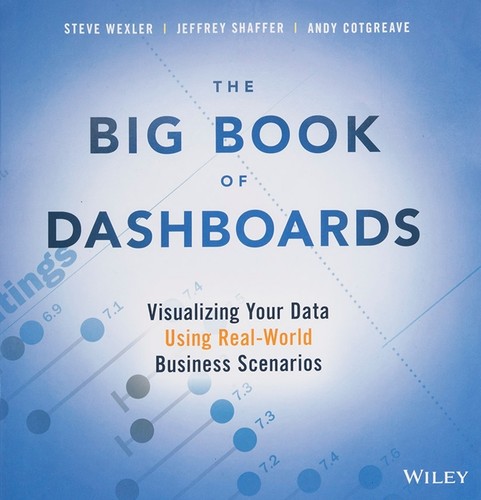Navigating the Dashboard Landscape: A Strategic Overview
In “The Big Book of Dashboards,” Steve Wexler, Jeffrey Shaffer, and Andy Cotgreave offer a robust manual for mastering dashboards in a professional environment. This work is a rich repository of insights and practical tips for professionals aiming to harness dashboards for improved decision-making and strategic planning. This summary distills the essence of the book into actionable insights, structured around several key themes that align with the overarching narrative of digital transformation and strategic business management.
The Foundations of Effective Dashboards
At the heart of effective dashboard design lies the ability to convey complex data clearly and concisely. This requires a profound understanding of both the data and the needs of the end-user. The authors emphasize starting with a clear objective: What decision or action should the dashboard inform? This question guides the design process, ensuring that every element on the dashboard serves a purpose.
Drawing parallels to design thinking, the book suggests an iterative approach to dashboard creation. Similar to product design, where user feedback is crucial, dashboards should be tested and refined based on user interaction. This iterative process ensures the final product is not only visually appealing but also functionally effective. In comparison, “How to Measure Anything” by Douglas W. Hubbard discusses similar themes in measurement, focusing on clarity and the iterative process of refinement, which is vital for effective decision-making.
Strategic Integration of Dashboards in Business Processes
Dashboards are not merely tools for data visualization; they are integral components of a broader business strategy. Wexler et al. argue that dashboards should be seamlessly integrated into existing business processes to enhance decision-making and drive strategic initiatives. This involves aligning dashboard metrics with key performance indicators (KPIs) and business objectives.
The book introduces several frameworks for aligning dashboards with business strategy, drawing on concepts from other notable works such as Jim Collins’ “Good to Great” and Michael Porter’s “Competitive Strategy.” By positioning dashboards as strategic assets, organizations can ensure they are proactive drivers of business success rather than reactive tools.
The Role of Dashboards in Digital Transformation
In the age of digital transformation, dashboards play a crucial role in helping organizations adapt to rapidly changing environments. The authors highlight the importance of agility in dashboard design and implementation, echoing themes from works like “The Lean Startup” by Eric Ries. Agile dashboards are flexible, scalable, and capable of evolving with the organization’s needs.
The book explores how dashboards can support digital transformation initiatives by providing real-time insights and fostering a data-driven culture. By democratizing access to data, dashboards empower employees at all levels to make informed decisions, driving innovation and efficiency. This approach parallels the ideas in “Competing on Analytics” by Thomas Davenport and Jeanne Harris, where leveraging analytics for competitive advantage is emphasized.
Leveraging Advanced Analytics and AI
As technology evolves, so too do the capabilities of dashboards. The authors explore the integration of advanced analytics and artificial intelligence (AI) into dashboard design, offering a glimpse into the future of data visualization. By incorporating predictive analytics and machine learning algorithms, dashboards can move beyond descriptive analytics to provide prescriptive and predictive insights.
This section of the book draws on concepts from “Predictive Analytics” by Eric Siegel, illustrating how organizations can harness AI’s power to anticipate trends, identify opportunities, and mitigate risks. The authors emphasize understanding AI’s limitations and ensuring human oversight remains a critical component of the decision-making process. By balancing AI’s capabilities with human insight, organizations can maximize their dashboards’ effectiveness.
Cultivating a Data-Driven Culture
For dashboards to be truly effective, organizations must foster a culture that values data-driven decision-making. The authors discuss strategies for cultivating such a culture, drawing on insights from “Data-Driven” by Thomas C. Redman. This involves not only providing access to data but also investing in data literacy training and encouraging a mindset of curiosity and continuous learning.
The book highlights the role of leadership in driving cultural change, emphasizing the need for leaders to model data-driven behaviors and champion the use of dashboards across the organization. By creating an environment where data is valued and utilized, organizations can unlock the full potential of their dashboards.
Practical Applications and Case Studies
Throughout the book, Wexler et al. provide numerous case studies and examples of successful dashboard implementations across various industries. These real-world examples illustrate the diverse applications of dashboards, from healthcare to finance to retail. Each case study offers valuable lessons, highlighting both the challenges and successes encountered along the way.
The authors also provide practical tips and best practices for overcoming common pitfalls in dashboard design and implementation. These include strategies for managing data quality, ensuring user adoption, and maintaining the relevance of dashboard content over time. By applying these best practices, organizations can ensure their dashboards remain effective and relevant in a rapidly changing business environment.
Conclusion: The Future of Dashboards in Business
“The Big Book of Dashboards” concludes with a forward-looking perspective on the future of dashboards in business. As technology continues to advance, the potential for dashboards to drive strategic decision-making and business transformation will only grow. The authors encourage professionals to embrace this potential, leveraging dashboards as powerful tools for navigating the complexities of the modern business landscape.
By synthesizing the insights and frameworks presented in the book, professionals can apply these lessons to their own organizations, driving innovation and achieving strategic objectives. Whether you are a business leader, data analyst, or IT professional, “The Big Book of Dashboards” offers valuable guidance for harnessing the power of dashboards to achieve success in the digital age.

